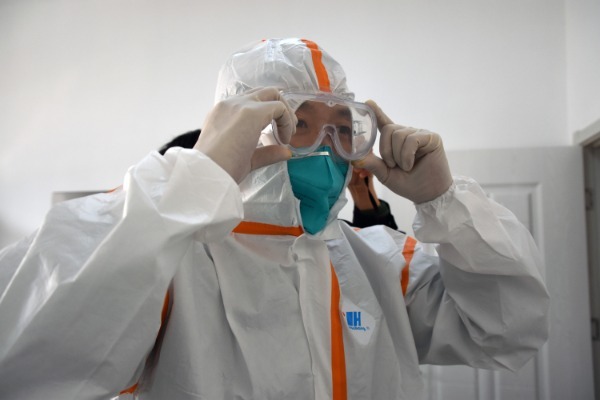Driver takes safety-first route to help

Shi Xuebin, an ambulance driver for the Medical Emergency Center in Tianjin, puts on protective goggles and clothing before a mission on Feb 19.[Photo/Xinhua]
TIANJIN-Dressed head to toe in protective clothing, Shi Xuebin climbs aboard his vehicle to transport his special passengers-patients confirmed or suspected to have been infected with COVID-19.
As a seasoned ambulance driver for the Medical Emergency Center in North China's Tianjin municipality, 46-year-old Shi volunteered to transfer patients by negative pressure ambulance, also known as a "mobile isolation ward" equipped with a negative pressure purification system, during the outbreak.
His first mission came on Jan 25, the first day of the Chinese Lunar New Year, when he was asked to transfer an infected man in his 30s to Tianjin Haihe Hospital, the city's first designated hospital to accommodate coronavirus-infected patients.
Shi wore a protective suit, an N95 respirator, a pair of medical goggles, two pairs of latex gloves and waterproof protective boots. While en route, doctors asked for basic information about the patient and measured his body temperature, heart rate and blood oxygen levels.
"The patient was really nervous about his condition as the COVID-19 cure rate was not clear at that time. Doctors just kept a proper distance, but not too much, from him. And we tried our best to soothe him," Shi recalls.
The job was far more challenging than he had expected. Soon, Shi's goggles started fogging up and his sight was blurred."I had to concentrate even more on the road," he says.
After a transfer is completed, every corner of the ambulance must be fully disinfected in the designated area of the hospital to prevent cross-infection. The driver and doctors have to spray disinfectant all over each other's body.
"I couldn't help but shiver after the outdoor disinfectant shower. Tianjin's winter can be really cold," Shi says. Then he could finally take off the suit and dispose of it at the designated place.
